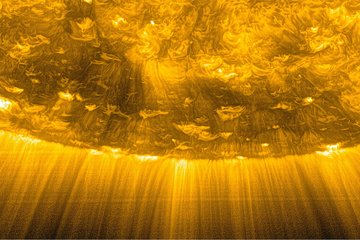All genres
1.
Journal Article
On structural properties of Comet 67/P dust particles collected in situ by ROSETTA/COSIMA from observations of electrical fragmentation. Planetary and Space Science 236, p. 105747 (2023)
2.
Journal Article
On structural properties of Comet 67/P dust particles collected in situ by ROSETTA/COSIMA from observations of electrical fragmentation. Planetary and Space Science 236, p. 105747 (2023)
3.
Journal Article
D/H in the refractory organics of comet 67P/Churyumov-Gerasimenko measured by Rosetta/COSIMA. Monthly Notices of the Royal Astronomical Society 504 (4), pp. 4940 - 4951 (2021)
4.
Journal Article
Electrical properties of cometary dust particles derived from line shapes of TOF-SIMS spectra measured by the ROSETTA/COSIMA instrument. Planetary and Space Science 182, 104758 (2020)
5.
Journal Article
Electrical properties of cometary dust particles derived from line shapes of TOF-SIMS spectra measured by the ROSETTA/COSIMA instrument. Planetary and Space Science 182, p. 104758 (2020)
6.
Journal Article
The morphological, elastic, and electric properties of dust aggregates in comets: A close look at COSIMA/Rosetta’s data on dust in comet 67P/Churyumov-Gerasimenko. Planetary and Space Science 181, 104825 (2020)
7.
Journal Article
Grain formation around the AGB star l2 puppis based on alma observations. The Astrophysical Journal 901 (2), 144 (2020)
8.
Journal Article
Composition of cometary particles collected during two periods of the Rosetta mission: multivariate evaluation of mass spectral data. Journal of Chemometrics 34 (4), e3218 (2020)
9.
Journal Article
Synthesis of the morphological description of cometary dust at comet 67P/Churyumov-Gerasimenko. Astronomy and Astrophysics 630, A24 (2019)
10.
Journal Article
H/C elemental ratio of the refractory organic matter in cometary particles of 67P/Churyumov-Gerasimenko. Astronomy and Astrophysics 630, A27 (2019)
11.
Journal Article
The oxygen isotopic composition (18O/16O) in the dust of comet 67P/Churyumov-Gerasimenko measured by COSIMA on-board Rosetta. Monthly Notices of the Royal Astronomical Society 477 (3), pp. 3836 - 3844 (2018)
12.
Journal Article
Errata: Searching for calcium‐aluminum‐rich inclusions in cometary particles with Rosetta/COSIMA. Meteoritics and Planetary Science 53 (3), pp. 549 - 550 (2018)
13.
Journal Article
Carbon-rich dust in comet 67P/Churyumov-Gerasimenko measured by COSIMA/Rosetta. Monthly Notices of the Royal Astronomical Society 469 (Suppl. 2), pp. S712 - S722 (2017)
14.
Journal Article
Nitrogen to carbon atomic ratio measured by COSIMA in the particles of comet 67P/Churyumov-Gerasimenko. Mon. Not. Roy. Astron. Soc. 469, pp. S506 - S516 (2017)
15.
Journal Article
Mechanical and electrostatic experiments with dust particles collected in the inner coma of comet 67P by COSIMA onboard Rosetta. Philosophical Transactions of the Royal Society A 375 (2097), 20160255 (2017)
16.
Journal Article
The 34S/32S Isotopic Ratio Measured in the Dust of Comet 67P/Churyumov-Gerasimenko by Rosetta/COSIMA. Mon. Not. Roy. Astron. Soc. 469, pp. S230 - S237 (2017)
17.
Journal Article
Similarities in Element Content between Comet 67P/Churyumov-Gerasimenko Coma Dust and Selected Meteorite Samples. Mon. Not. Roy. Astron. Soc. 469, pp. S492 - S505 (2017)
18.
Journal Article
High-molecular-weight organic matter in the particles of comet 67P/Churyumov-Gerasimenko. Nature 538, pp. 72 - 74 (2016)
19.
Journal Article
Composition of Dust Particles Collected in Inner Coma of Comet 67P/Churyumov_Gerasimenko by Rosetta/Cosima. Meteorit. Planet. Sci. 51, p. A330 - A330 (2016)
20.
Journal Article
Comet 67P/ChuryumovGerasimenko: Close-up on Dust Particle Fragments. The Astrophysical Journal Letters 816, L32 (2016)










